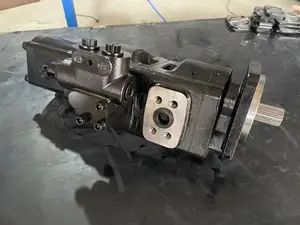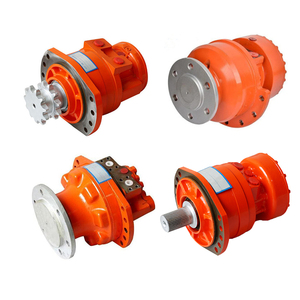The radial piston motor is an intricate piece of machinery engineered to transform hydraulic energy into mechanical power via multiple pistons arrayed radially around a central crankshaft. Renowned for their exceptional efficiency and capacity to generate substantial torque at reduced speeds, these motors are indispensable across a broad spectrum of industrial uses.
Types and Characteristics of Radial Piston Motors
Radial piston motors are differentiated by their construction and intended use. The gear motor, a less complex variant, is preferred for its dependability and maintenance simplicity. Vane motors offer a compromise between power and precision in a more compact package, though they are less prevalent in heavy-duty roles. The piston motor, encompassing the radial type, is celebrated for its formidable torque and efficiency. Within this category, distinctions arise from the number of pistons and the design nuances of the cam and crank mechanisms. Certain models, such as the Rexroth Jmcr series or the Hagglunds CA series, are customized for specialized tasks demanding robust performance in harsh conditions.
Structure and Operation of Radial Piston Motors
The architecture of a radial piston motor is a testament to engineering prowess, featuring a durable housing that contains pistons positioned radially around a central shaft. These pistons are driven by hydraulic fluid, regulated by an advanced valve system. Fluctuations in fluid pressure drive the pistons in and out, exerting force on the cam track connected to the crankshaft, thus producing rotational motion. This system's precision enables meticulous control over the motor's output, suitable for tasks that demand exact power modulation.
Materials and Properties
Materials selected for radial piston motors are based on their mechanical characteristics and environmental compatibility. Carbon steel is the material of choice for its high tensile strength and endurance, essential for withstanding the repetitive stress on the motor's internals. Cast iron is commonly employed for the motor casing due to its superior vibration absorption and resistance to wear and deformation under heavy loads. These materials not only confer durability but also contribute to the motor's consistent performance over time, a crucial aspect of reliability in industrial contexts.
Business Usages and Applications
The radial piston motor is utilized in a plethora of commercial settings, each demanding distinct motor capabilities. In sectors like construction and mining, these motors deliver the necessary high torque for tasks such as drilling, lifting, and excavation. In precision manufacturing, they afford the fine control needed for intricate assembly operations. Within the marine sector, their dependability and strength are vital for managing winches and cranes in the challenging conditions at sea. The adaptability of these motors enhances business efficiency across these diverse sectors by boosting operational effectiveness, curtailing energy use, and ensuring durability for sustained, intensive use.
Functions and Tasks
A radial piston motor is adept at performing a range of functions, tailored to the application. Its principal role is to convert hydraulic pressure into rotational force, useful for propelling wheels, machinery, or gears. The motor's proficiency in delivering high torque at low speeds is especially advantageous for applications requiring potent, controlled movements, such as material handling equipment where precise lifting and positioning are crucial. Moreover, the motor's design accommodates applications that necessitate reverse functionality, enhancing its versatility.
Features and Unique Selling Points
The distinctive selling propositions of radial piston motors are encapsulated in their design and operational features. These motors are typified by their robust starting torque, expansive speed range, and capacity to endure high radial loads, qualifying them for the most strenuous tasks. Their compact size relative to power output is a significant advantage in environments where space is at a premium. Additionally, the radial piston motor's consistent efficiency across various operating conditions distinguishes it from other motor types, offering a combination of performance and flexibility.
Benefits and Positive Outcomes
Integrating radial piston motors into industrial processes yields numerous advantages. Their ability to produce high torque at low speeds obviates the need for gear reductions, streamlining the drive system and diminishing maintenance demands. The motors' smooth operation reduces vibrations, thereby decreasing wear on connected equipment and prolonging the system's overall lifespan. For enterprises, this equates to a lower total cost of ownership and diminished operational costs. Moreover, the precise control enabled by radial piston motors can enhance product quality and uniformity in manufacturing settings.
How to Use and Operate Effectively
To effectively utilize a radial piston motor, a comprehensive grasp of the encompassing hydraulic system is essential. Operators must be adept at adjusting hydraulic fluid flow and pressure to regulate the motor's speed and torque. It is also critical to ensure the motor is properly integrated into the mechanical system it powers, with correct alignment and coupling to avert undue strain on the motor's shaft and bearings.
How to Choose the Right Radial Piston Motor
Selecting the appropriate radial piston motor necessitates an in-depth understanding of the application's demands. Considerations such as load, speed, torque, and duty cycle are paramount. The operating environment, including temperature fluctuations and potential exposure to corrosive elements, should also inform the choice of motor materials and sealing solutions. Engaging with technical specialists and suppliers on Alibaba.com can offer invaluable insights, ensuring the chosen motor not only fulfills but surpasses performance expectations.
How to Maintain and Extend Lifespan
Proactive maintenance is key to preserving a radial piston motor. Regular checks for seal wear, bearing deterioration, and unusual sounds or vibrations are imperative to identify internal complications. Maintaining the purity of the hydraulic fluid is vital, as its cleanliness directly impacts the motor's function and durability. Adhering to the manufacturer's maintenance guidelines and using authentic replacement parts can significantly prolong the motor's service life.
Target Audience and Meeting Needs
The intended market for radial piston motors encompasses a wide array of sectors in need of dependable and efficient hydraulic power. These motors are engineered to satisfy the stringent requirements of industries such as aerospace, where precision and reliability are non-negotiable, and agriculture, where toughness and resilience are essential. By discerning the specific needs and preferences of these varied markets, radial piston motor producers can customize their products to deliver the most effective and efficient solutions to their clientele.


































 浙公网安备 33010002000092号
浙公网安备 33010002000092号 浙B2-20120091-4
浙B2-20120091-4